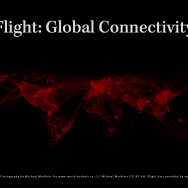 I guess we can call this part two of the global connectivity by flight experiment, which I have been working on the past couple of days. Once again, the data comes from openflights.org/data.html and is available for free to the public. It is a very detailed set of data that requires just a little bit of massaging to be usable in a desktop work environment. In this blog post I would like to take you through some quick helpful tips that should get you from downloading the data and cleaning it up to mapping it in ArcMap. In all honesty, I would have loved Continue reading »
I guess we can call this part two of the global connectivity by flight experiment, which I have been working on the past couple of days. Once again, the data comes from openflights.org/data.html and is available for free to the public. It is a very detailed set of data that requires just a little bit of massaging to be usable in a desktop work environment. In this blog post I would like to take you through some quick helpful tips that should get you from downloading the data and cleaning it up to mapping it in ArcMap. In all honesty, I would have loved Continue reading »
 After having seen the many iterations of the global connectivity map, I have decided to give it a try myself. The maps are being produced using this data, which offers public air-traffic data in tabular format. The data is available in three categories: airports, airlines and routes. The airports and routes data can be manipulated, combined and cleaned-up to create a complimentary table that lists the longitude and latitude of each flights origin and destination. This allows us to connect each flight origin and destination. However, straight lines of Continue reading »
After having seen the many iterations of the global connectivity map, I have decided to give it a try myself. The maps are being produced using this data, which offers public air-traffic data in tabular format. The data is available in three categories: airports, airlines and routes. The airports and routes data can be manipulated, combined and cleaned-up to create a complimentary table that lists the longitude and latitude of each flights origin and destination. This allows us to connect each flight origin and destination. However, straight lines of Continue reading »
 My intentions for this blog are to spur intelligent and thought provoking discussions and to provide some insight and/or help to those who may want to delve into various spatial analyses and cartographic trends/methodologies. Cartograms are definitely one of the most trending topics in discussions on how to alternatively geovisualize spatial phenomena. The idea roots back more than half a decade and has evolved from a ‘pencil and graph paper’ skill to a geographical information system (GIS) tool{box}. We can add… Continue reading »
My intentions for this blog are to spur intelligent and thought provoking discussions and to provide some insight and/or help to those who may want to delve into various spatial analyses and cartographic trends/methodologies. Cartograms are definitely one of the most trending topics in discussions on how to alternatively geovisualize spatial phenomena. The idea roots back more than half a decade and has evolved from a ‘pencil and graph paper’ skill to a geographical information system (GIS) tool{box}. We can add… Continue reading »
